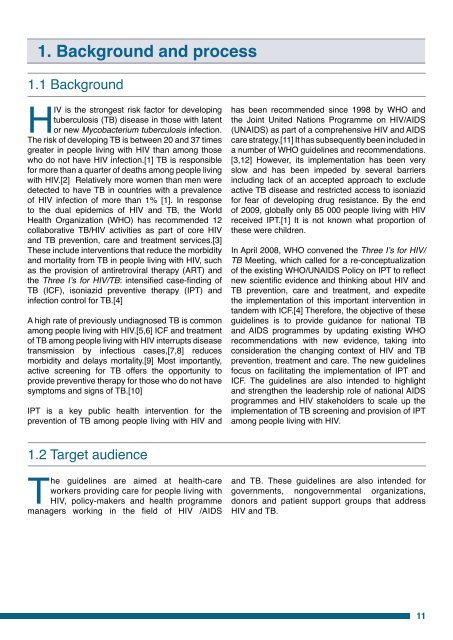Guidelines for intensified tuberculosis case-finding and isoniazid ...
Guidelines for intensified tuberculosis case-finding and isoniazid ...
Guidelines for intensified tuberculosis case-finding and isoniazid ...
Create successful ePaper yourself
Turn your PDF publications into a flip-book with our unique Google optimized e-Paper software.
1. Background <strong>and</strong> process1.1 BackgroundHIV is the strongest risk factor <strong>for</strong> developing<strong>tuberculosis</strong> (TB) disease in those with latentor new Mycobacterium <strong>tuberculosis</strong> infection.The risk of developing TB is between 20 <strong>and</strong> 37 timesgreater in people living with HIV than among thosewho do not have HIV infection.[1] TB is responsible<strong>for</strong> more than a quarter of deaths among people livingwith HIV.[2] Relatively more women than men weredetected to have TB in countries with a prevalenceof HIV infection of more than 1% [1]. In responseto the dual epidemics of HIV <strong>and</strong> TB, the WorldHealth Organization (WHO) has recommended 12collaborative TB/HIV activities as part of core HIV<strong>and</strong> TB prevention, care <strong>and</strong> treatment services.[3]These include interventions that reduce the morbidity<strong>and</strong> mortality from TB in people living with HIV, suchas the provision of antiretroviral therapy (ART) <strong>and</strong>the Three I’s <strong>for</strong> HIV/TB: <strong>intensified</strong> <strong>case</strong>-<strong>finding</strong> ofTB (ICF), <strong>isoniazid</strong> preventive therapy (IPT) <strong>and</strong>infection control <strong>for</strong> TB.[4]A high rate of previously undiagnosed TB is commonamong people living with HIV.[5,6] ICF <strong>and</strong> treatmentof TB among people living with HIV interrupts diseasetransmission by infectious <strong>case</strong>s,[7,8] reducesmorbidity <strong>and</strong> delays mortality.[9] Most importantly,active screening <strong>for</strong> TB offers the opportunity toprovide preventive therapy <strong>for</strong> those who do not havesymptoms <strong>and</strong> signs of TB.[10]IPT is a key public health intervention <strong>for</strong> theprevention of TB among people living with HIV <strong>and</strong>has been recommended since 1998 by WHO <strong>and</strong>the Joint United Nations Programme on HIV/AIDS(UNAIDS) as part of a comprehensive HIV <strong>and</strong> AIDScare strategy.[11] It has subsequently been included ina number of WHO guidelines <strong>and</strong> recommendations.[3,12] However, its implementation has been veryslow <strong>and</strong> has been impeded by several barriersincluding lack of an accepted approach to excludeactive TB disease <strong>and</strong> restricted access to <strong>isoniazid</strong><strong>for</strong> fear of developing drug resistance. By the endof 2009, globally only 85 000 people living with HIVreceived IPT.[1] It is not known what proportion ofthese were children.In April 2008, WHO convened the Three I’s <strong>for</strong> HIV/TB Meeting, which called <strong>for</strong> a re-conceptualizationof the existing WHO/UNAIDS Policy on IPT to reflectnew scientific evidence <strong>and</strong> thinking about HIV <strong>and</strong>TB prevention, care <strong>and</strong> treatment, <strong>and</strong> expeditethe implementation of this important intervention int<strong>and</strong>em with ICF.[4] There<strong>for</strong>e, the objective of theseguidelines is to provide guidance <strong>for</strong> national TB<strong>and</strong> AIDS programmes by updating existing WHOrecommendations with new evidence, taking intoconsideration the changing context of HIV <strong>and</strong> TBprevention, treatment <strong>and</strong> care. The new guidelinesfocus on facilitating the implementation of IPT <strong>and</strong>ICF. The guidelines are also intended to highlight<strong>and</strong> strengthen the leadership role of national AIDSprogrammes <strong>and</strong> HIV stakeholders to scale up theimplementation of TB screening <strong>and</strong> provision of IPTamong people living with HIV.1.2 Target audienceThe guidelines are aimed at health-careworkers providing care <strong>for</strong> people living withHIV, policy-makers <strong>and</strong> health programmemanagers working in the field of HIV /AIDS<strong>and</strong> TB. These guidelines are also intended <strong>for</strong>governments, nongovernmental organizations,donors <strong>and</strong> patient support groups that addressHIV <strong>and</strong> TB.11















